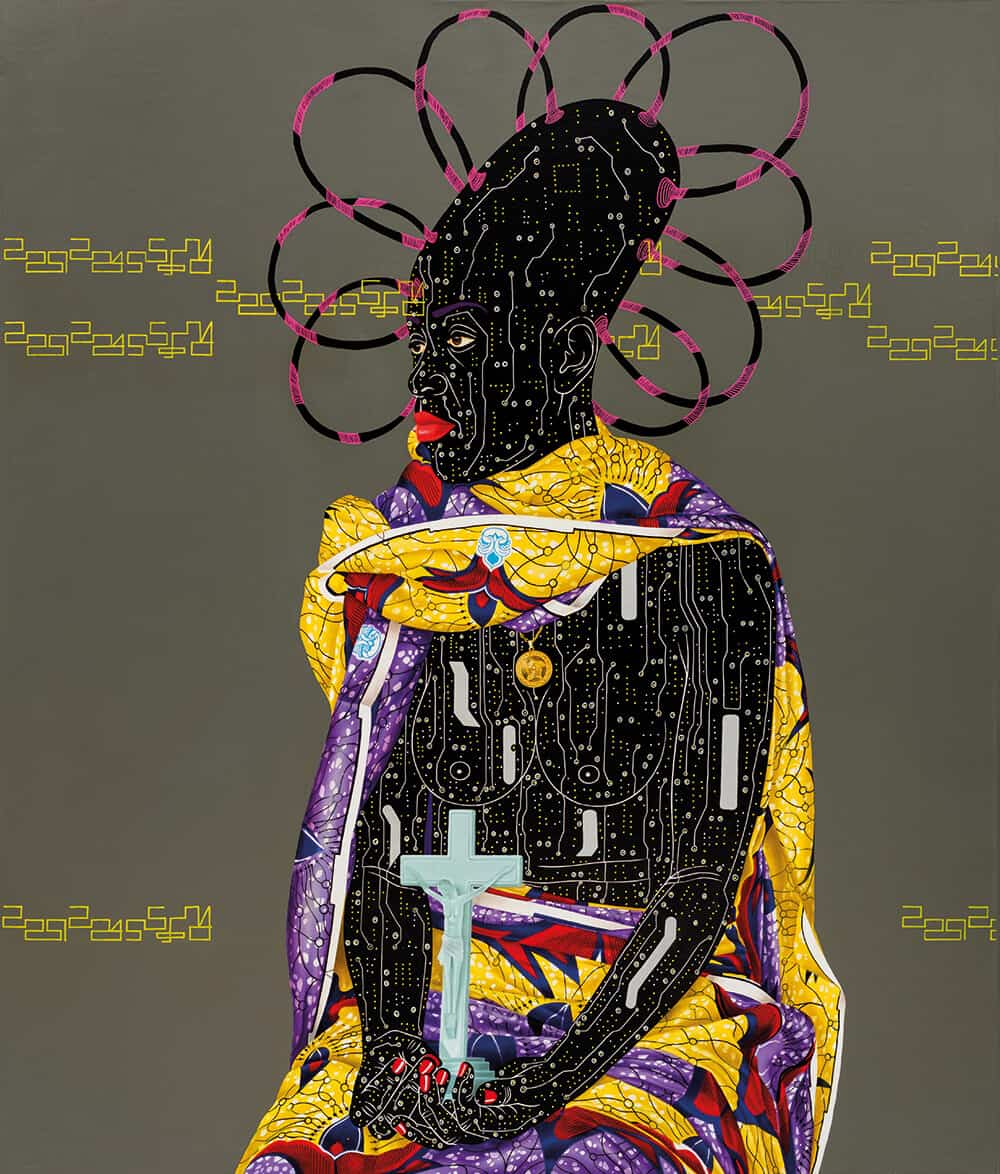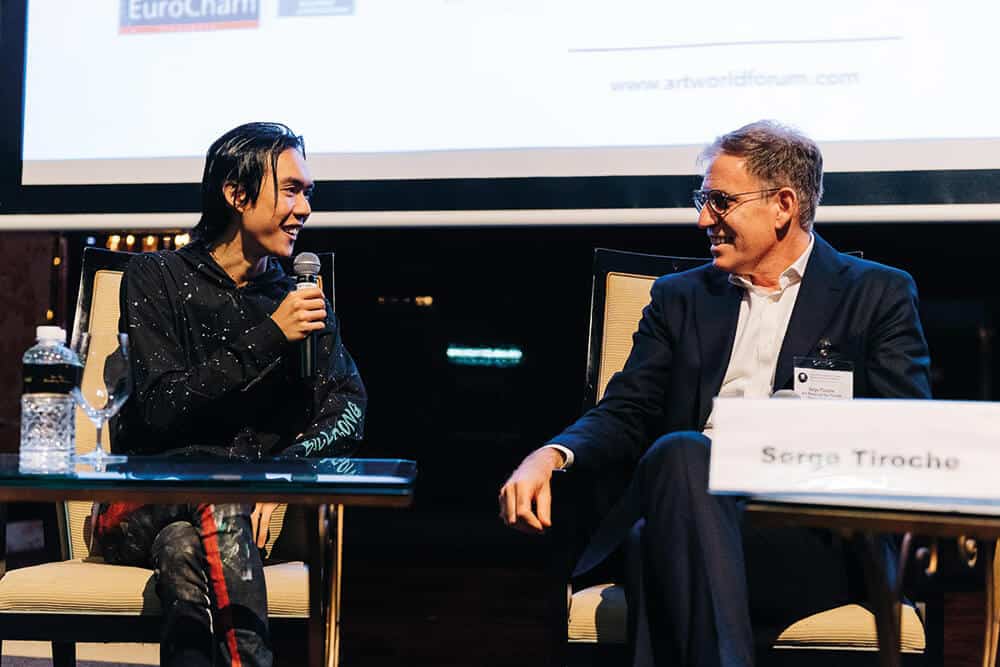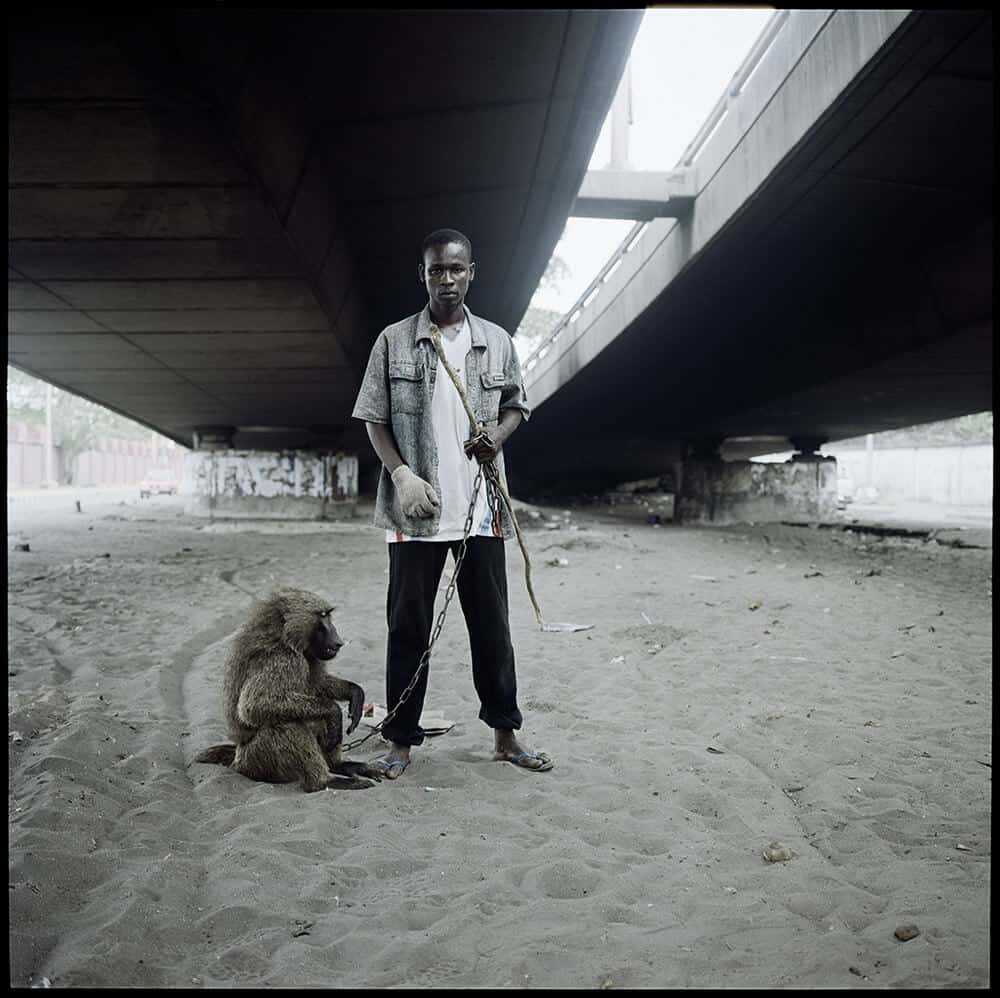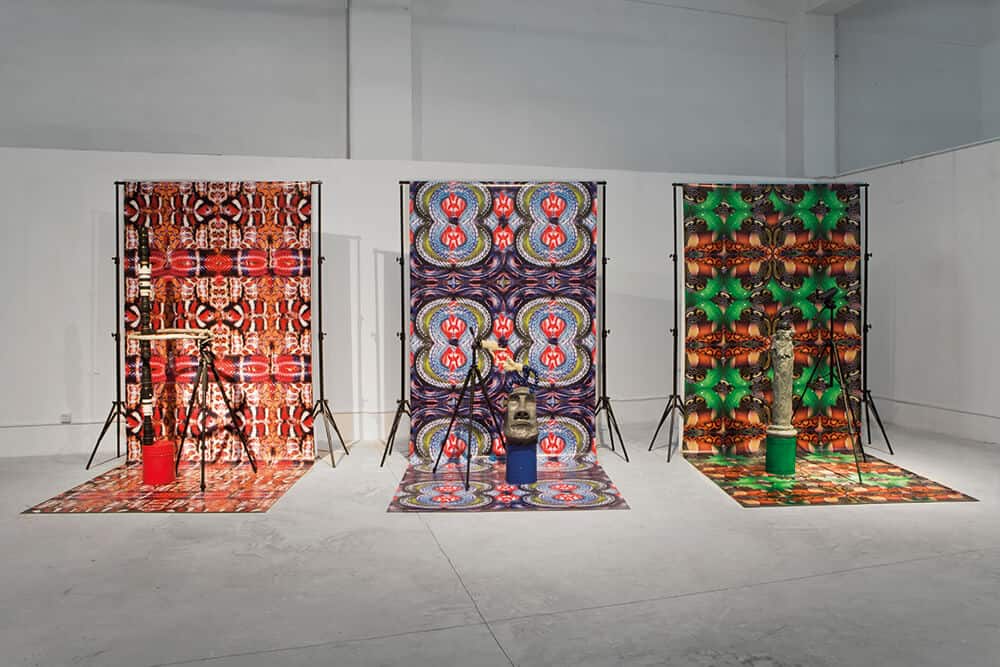COLLECTOR in conversation with Serge Tiroche
Serge Tiroche, co-founder of the Tiroche DeLeon Collection, was born in Israel to a family of art dealers. It was while at university that Tiroche bought his first piece of art, a painting by Israeli artist Tsibi Geva who represented Israel in Venice some 25 years later in 2015. After a 10-year career in the finance industry, Tiroche merged his investment knowledge with his passion for art and among other ventures, co-founded the Tiroche DeLeon Collection in 2011 – the first art investment fund modelled on a private collection. The fund now holds over 400 pieces and has established its global presence as a platform that bridges the gap between art and asset. Tiroche still owns that first Tsibi Geva artwork. The collection’s purchases are testament to Tiroche’s impeccable and precise intuition, both from an investment perspective and from a curatorial perspective.
 Eddy Kamuanga, Influence, 2016. Acrylic and oil on canvas, 170 x 150 cm. Courtesy of Tiroche DeLeon Foundation.
Eddy Kamuanga, Influence, 2016. Acrylic and oil on canvas, 170 x 150 cm. Courtesy of Tiroche DeLeon Foundation.
COLLECTOR: Your collection and business works on a global art-lending programme – collaborating and loaning works to galleries, independent curators, museum directors, fairs and biennales. What is your preferred, most rewarding, method of art lending/collaboration – with whom and how?
Serge Tiroche: We like to lend works from the collection for several reasons. Firstly, we prefer that the art is seen rather than being in storage, so in that sense our preferred loans are long term. The best loans are to our own investors who get to enjoy the art in their homes and share it with their friends and family. It is really a way to engage them in art collecting. But, of course, we also lend to museums and biennales. We made a few long-term museum loans but generally our museum and biennale loans are exhibition based and can last anywhere from three months to 24 months in the case of travelling shows. Another way to show our works is to initiate collaborations with various art spaces, such as the two iterations we did of the exhibition of highlights of our Latin American collection at Mana Contemporary in Miami (2015) and New Jersey (2016). This was the most rewarding as it was a large-scale exhibition curated by Catherine Petitgas and truly demonstrated the depth and strength of our collection, reaping rewards from the media, critics and collectors alike.
What is your process behind finding new artists and purchasing works for the collection?
The process involves continuous research by reading and reviewing hundreds of artist portfolios, gallery emails, journals, auction catalogues, etc. But more importantly for me, it involves travelling to meet the artists at exhibitions and in their studios. We also initiated a residency programme in Israel for artists from all over the world with whom I get to build personal, lasting relationships. The choice of artists and artworks revolves around multiple criteria. Firstly, I must be attracted to the works. I am attracted to works when the quality of the production is high, when the work is authentic and unique, when it speaks a personal language and when I find aesthetic pleasure. But liking the work is only the first step. Then I need to know the artist, understand the trajectory, the dedication and the ambition. Then I’m generally interested about how the artist is supported in their home country by their gallery, collectors, curators, etc. and finally, I must believe that the work can speak an international language so the career can grow internationally.
… I must believe that the work can speak an international language so the career can grow internationally.
With regard to commercialised art collections, do you feel that there is a major difference in investment value between commercial art versus more experimental art? And how do you balance your own collection style?
This is an interesting question, but the answer really depends on the definition of experimental versus commercial. For me, the category of ‘experimental’ works means large-scale works, installations and digital works that are more difficult to resell. Commercial means domestic-scale works that potentially could easily be sold via auction. In our collection, we have a relatively large amount of ‘experimental’ and that is intentional. I always say that, despite being an art fund, we are not purely interested in making money. We are interested in a project that could have a lasting impact on the careers of artists, on expanding the collector scene, on bringing value and interest to audiences around the world, in inspiring young collectors and in serving the interests of everyone in the art ecosystem – artists, galleries, museums, curators, auction houses and the public. We hope our collection is notable historically. Ultimately, I would like to prove that doing the right thing for the art is not contradictory to making financial gain.
The Tiroche DeLeon Collection has both established artists and younger contemporary artists – where, in your opinion, lies the focus and interest for your clients?
Correct. Our approach has been to have a bar-bell investment strategy. In each of the art scenes we invest in, we try to identify the leading contemporary artists that inspire the younger generation. We buy their works at relatively high prices and hope that their value will increase at a steady pace. These works serve as the conservative part of the investment portfolio and provide stability, visibility and liquidity, when needed. Our return expectation is 5–10% per annum on these works.
These works are smaller in number but account for 60–70% of the fund’s investments. The emerging artist’s that we support are generally our own discoveries. This is the exploratory part and the most fun. Here we can go completely wrong and virtually loose our entire investment or get it amazingly right, as we have proved we are able to do with numerous artists – Adrian Villar Rojas, Rodel Tapaya, Cui Jie, Ruben Pang, Guan Xiao, Igshaan Adams, etc. … Getting this right could mean returns in excess of 100% annualised, as we have already had in a few instances. I think our investors find interest in both strategies and really trust my judgement in these matters. I have lived and breathed art for several decades now and, in the past 10 years, I have dedicated 100% of my time to it, so hopefully, I can make a few good decisions.
 Ruben Pang in conversation with Serge Tiroche at Art World Forum, Singapore, 2016.
Ruben Pang in conversation with Serge Tiroche at Art World Forum, Singapore, 2016.
When it becomes time to sell a piece – is this decision driven by the financial incentive or rather to create space for a new artist and discovery?
We sell for different reasons. So far, we’ve sold a total of 47 works in the fund. These sales have generated a gross realised return (before management and performance fees) of 20% per annum. That is a huge achievement and serves as an important proof of concept as we set out to raise our next fund. Total sales amounted to over US$ 7 million, which is also a sizable number, particularly for art in emerging markets. Some of the large sales were simply to take advantage of ‘hot’ markets for certain artists and to arbitrage the secondary market with the primary market. In other cases, we sold the work of younger artists, from whom we had bought numerous examples, and were able to sell the less good ones and keep the best, while at the same time demonstrating our ability to select the right names early on, while also helping the artists and their galleries by creating robust secondary markets. The proceeds were generally used to reinvest in other emerging talents, creating a virtuous circle of support for the market of certain emerging artists. As we now are in the second phase of the fund’s life cycle, the ‘holding and consolidation’ phase, we will seek to sell some of our less successful and non-essential works to fund ongoing activity and meet redemption requests.
 Pieter Hugo, Animal Handler with Ajasco, Lagos, Nigeria, 2007. Digital c-print, 152 x 152 cm, edition: 3/5 + 2 AP. Courtesy of Tiroche DeLeon Foundation.
Pieter Hugo, Animal Handler with Ajasco, Lagos, Nigeria, 2007. Digital c-print, 152 x 152 cm, edition: 3/5 + 2 AP. Courtesy of Tiroche DeLeon Foundation.
 Guan Xiao, The Documentary: Geocentric Puncture, 2012. Digital Print on vinyl, resin, colored metal, webcam, tripods, camera lenses, 230 x 280 x 210cm, edition: 2/3. Courtesy of Tiroche DeLeon Foundation.
Guan Xiao, The Documentary: Geocentric Puncture, 2012. Digital Print on vinyl, resin, colored metal, webcam, tripods, camera lenses, 230 x 280 x 210cm, edition: 2/3. Courtesy of Tiroche DeLeon Foundation.
Do you have any advice for young investors/young collectors?
I always share my knowledge via interviews, talks, my newsletters, my Instagram and now I have started allocating time to an online art market course I have been invited to lecture at. If I can inspire anyone to start collecting, that makes me extremely happy, even when they want to set-up other art funds, I encourage and help and provide advice. My best advice is to follow your heart and then work hard.
After you left the banking industry in 2008, you launched START, an artist incubator initiative based in Israel. START aims to support and mentor emerging artists while also demystifying the exclusivity of collecting – making it a possible venture for those who wish to invest and acquire art. The Tiroche DeLeon residency programme seems to be a more focused artist-support project that START originally initiated. You focus on artists from developing countries – has South Africa featured when you consider artists for the residency? And what is your opinion of emerging contemporary art and artists from the African continent?
Yes, I have been an avid supporter of a whole generation of Millennium artists in Israel. Over 150 have received some form of support from the START incubator in Israel – some still do. Since founding the Tiroche DeLeon Collection, I wanted to continue this in a more targeted fashion with young but highly talented artists that I meet along my travels in the developing world. I found out that whenever I mentioned I was from Israel, immediately the eyes of artists lit up, they were excited about the prospects of visiting one day, so we founded the Israel based residency in 2015. We’ve had seven artists so far, each spending anywhere between 1-3 months, exploring the country, getting inspired and creating a body of new work for an exhibition at the end of the residency. It’s been a great way to connect more deeply with artists, collect amazing works, and truly help shape their work via mentoring and experiences. It’s extremely rewarding. Three of the seven artists came from Africa: Isabelle Grobler from South Africa, Terrence Musekiwa from Zimbabwe and Mario Macilau from Mozambique. In 2018 we will have a few more African artists at the residency.
Ultimately, I would like to prove that doing the right thing for the art is not contradictory to making financial gain.
What countries are you particularly excited about with regard to new emerging artists? And what are your thoughts on the new Contemporary African Art Museum, the Zeitz MOCAA?
It is no secret that I have a huge interest in African contemporary art and am starting to think about my next fund in this context. (The investment period of the Tiroche DeLeon Collection ended earlier this year and we are not acquiring new works.) In the next fund, Africa and the African diaspora will have a very large allocation, hence I have already started investigating the African scenes in more depth. I was in Accra earlier this year and recently returned from the Zeitz MOCAA opening in Cape Town. My next stops are a research trip to Harare at the end of the month, followed by Lagos for ArtX.
As for the Zeitz MOCAA experience, my thoughts are pretty much aligned to the consensus I think. There is no doubt the opening of the museum is a hugely important milestone for the development of Contemporary Art on the continent. It provides artists an incredible platform to express their talents. Also, given its remarkable location and architecture, it is sure to lure in international art aficionados and create a unique encounter for them to discover the incredibly rich production of the continent. That said, I did feel that the curatorial selections for the first exhibition could have been better and more representative of the diversity, both locally in South Africa and more broadly on the continent. I am sure time pressure had a lot to do with this and I am convinced that this side of things will improve down the line. Overall, an incredible experience.
Finally, will the Tiroche DeLeon Collection ever have a museum/gallery space of its own?
No. That was never our intention. We think that nowadays there are a lot of available spaces to show art, but few collections that can offer such a fresh perspective on what’s happening on the edges of the art world, hence we hope to be able to collaborate with existing museums and foundations and provide our content.


LEFT: Romuald Hazoumè, Taillonné, 2015. Found objects, 35 x 24 x 15 cm. RIGHT: Romuald Hazoumè, Ma Poule, 2013. Found objects, 46 x 42 x 12cm. Images courtesy of the Tiroche DeLeon Foundation.
.
Tayla Withers is a writer on ART AFRICA’s editorial team.



